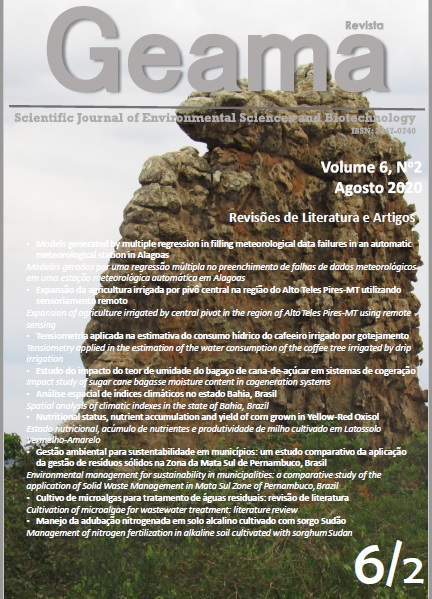Análise espacial de índices climáticos no estado Bahia, Brasil
Palavras-chave:
Agrometeorologia, SIG, ClimaResumo
O objetivo desse trabalho foi verificar a tendência espacial dos índices climáticos no estado da Bahia. Foram utilizados dados de 450 estações, 30 pertencentes ao Instituto Nacional de Meteorologia (INMET) e 420 da Agência Nacional de Águas (ANA). Os índices climáticos usados foram: Índice de Continentalidade de Johansson (ICJ), Índice de Oceaneidade de Kerner (IOK) e o Índice Combinativo de Pinna (ICP). Os mapas dos índices foram feitos através do software ArcGIS 10.3 a partir de técnicas geoestatísticas. Houve uma correlação linear entre os valores de ICJ e IOK. As condições semiáridas baianas aliadas as baixas precipitações em grande parte do Estado refletem no avanço da continentalidade em todo o território. À medida que há um distanciamento da costa em direção a parte central do Brasil, ocorre o aumento da continentalidade, isso se deve principalmente pelo efeito das coordenadas geográficas e precipitação local. Mais 70% do território do estado apresenta características de climas continentais, e apenas 15% representa o clima oceânico. A amplitude térmica atuou como principal fator meteorológico na determinação do ICJ e IOK. O IOK em regiões do hemisfério sul, em termos de valores, assume características diferentes quando comparadas aos resultados obtidos em regiões do hemisfério norte.Downloads
Referências
ADGER, N. et al. Climate change. Climate change impacts, adaptation and vulnerability: fourth assessment report. Disponível em: www.ipcc.ch . 2007
AMIRATAEE, B., MONTASERI, M., SANIKHANI, H. The analysis of trend variations of reference evapotranspiration via eliminating the significance effect of all autocorrelation coefficients. Theory Applied Climatology, 2015.
BALTAS, E. Spatial distribution of climatic indices in northern Greece. Meteorologica Applications, v. 14, p. 69-78, 2007.
CHEN, S. B., LIU, Y.F., THOMAS, A. Climatic change on the Tibetan plateau: potential evapotranspiration trends from 1961–2000. Climatic Change 76:291–319, 2006.
DALEZIOS, N. R., ZARPAS, C. D., The role of NDVI and meteorological indices in the phenology of cotton, vineyards and apples in Greece. International Symposium on Applied Agrometeorology and Agroclimatology, 24–26 April 1996 (Luxembourg: Office for Official Publications of the European Communities), pp. 185–190. 1996.
DALEZIOS, N., DOMENIKIOTIS, X., TZORTZIOS, S., LOUKAS, A., TZANETOPOULOU, I. The importance of the agrometeorological indicators on the development of the wheat crop in the area of Larisa. In Practical of the 2nd National Congress of Agricultural Mechanics, Volos. 2000.
DANTAS, A. A. A., CARVALHO, L. G., FERREIRA, E. Classificação e tendências climáticas em Lavras, MG. Ciênc. agrotec., Lavras , v. 31, n. 6, p. 1862-1866, Dec. 2007 . Available from <http://www.scielo.br/scielo.php?script=sci_arttext&pid=S1413-70542007000600039&lng=en&nrm=iso>. access on 20 Jan. 2020. http://dx.doi.org/10.1590/S1413-70542007000600039.
DENIZ, H., TOROS, S., INCECIK. Spatial variations of climate indices in turkey. International Journal of Climatology,. v 31: 394–403 (2011).
DE MARTONNE E. Traité de Géographie Physique: 3 tomes, Paris. Filatov N, Salo Y, Nazarova L. 2005. Effect of climate variability on natural water bodies in Northwest Russia. 15th International Northern Research Basins Symposium and Workshop. Lule°a to Kvikkjokk: Sweden. 1925.
FLOCAS, A. A., Courses of Meteorology and Climatology. Ziti Publications: Thessaloniki. 1994.
GAVILAN, R. G., The use of climatic parameters and indices in vegetation distribution: A case study in the Spanish Sistema Central. International Journal of Biometeorology, v. 50, p. 111-120, 2005.
KERNER F. Thermoisodromen, Versuch einer kartographischen Darstellung des jahrlichen Ganges der Lufttemperatur (Wien). K. K. Geographische Gesellschaft 6(3). 1905.
MCCOY, J., JOHNSTON, K. Using ArcGIS Spatial Analyst. GIS by ESRI: ESRI, Redlands, CA, USA. 2001.
SUBAK, S., et al. The impact of the anomalous weather of 1995 on the UK economy. Climatic Change, v. 44, p. 1-26, 2000.
RETUERTO R, CARBALLEIRA A. Use of direct gradient analysis to study the climate-vegetation relationship in Galicia, Spain. Vegetation 101: 183–194, 1992.
ZAMBAKAS, J. General Climatology. Department of Geology, National & Kapodistrian University of Athens: Athens, Greece, 1992.
Downloads
Publicado
Como Citar
Edição
Seção
Licença
As Políticas Culturais em Revista aplica a Licença Creative Commons Atribuição-Não Comercial 4.0 Internacional (CC BY-NC-SA 4.0) para os trabalhos que publica. Esta licença foi desenvolvida para facilitar o acesso aberto - ou seja, o acesso livre, imediato, e a reutilização irrestrita de trabalhos originais de todos os tipos. Nossos autores mantêm os direitos autorais mas, sob essa licença, concordam em deixar os artigos legalmente disponíveis para reutilização, sem necessidade de permissão ou taxas, para praticamente qualquer finalidade. Qualquer pessoa pode copiar, distribuir ou reutilizar esses artigos, desde que o autor e a fonte original (Políticas Culturais em Revista) sejam devidamente citados.
![]()






